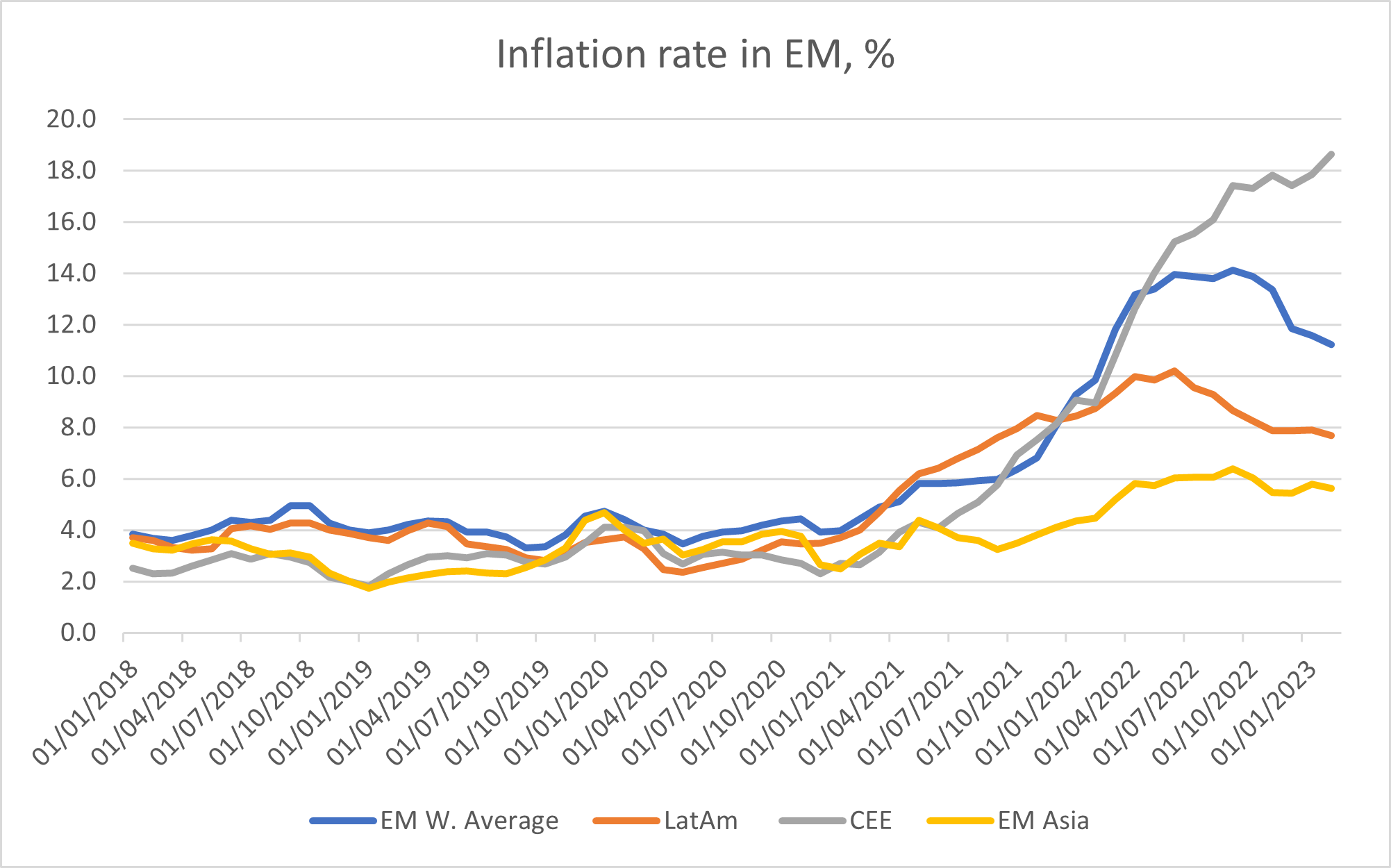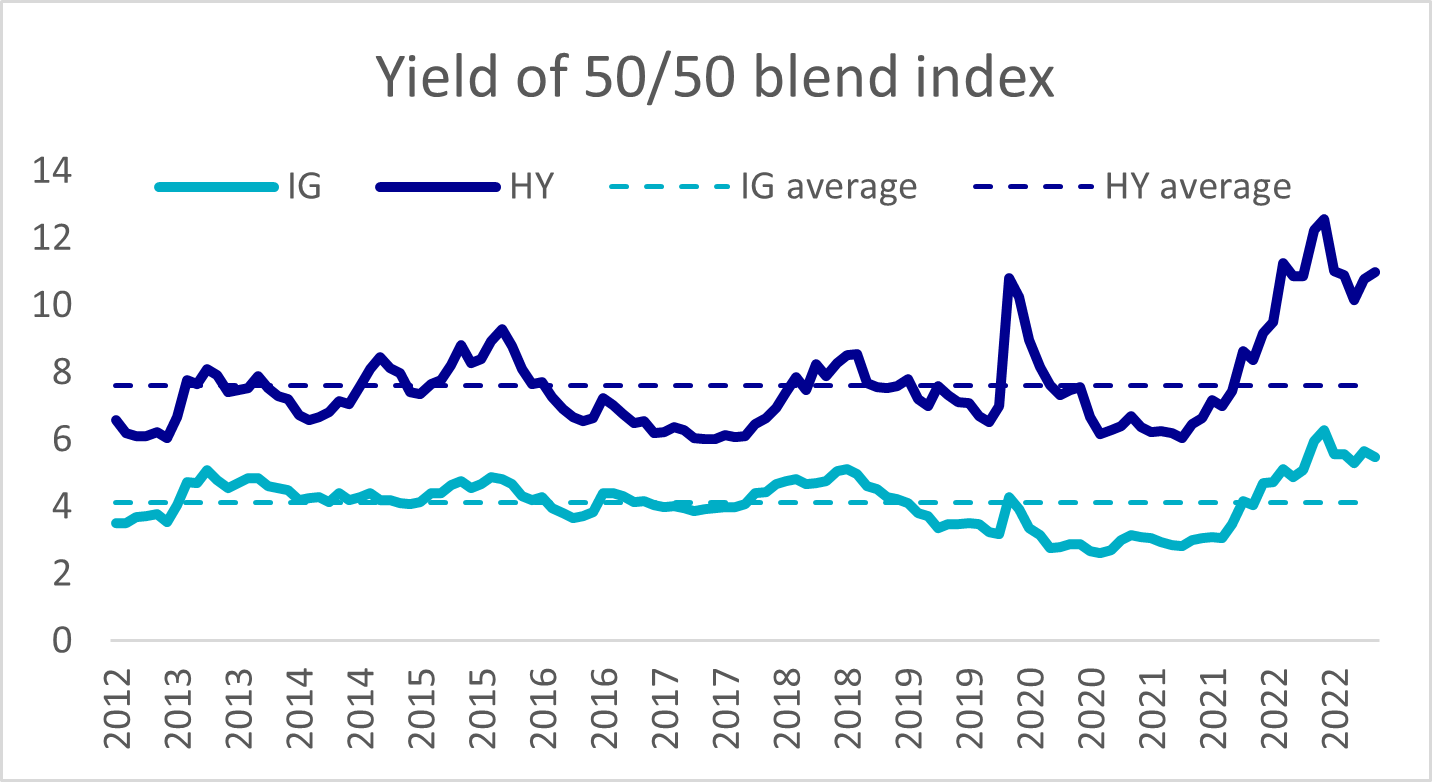
Is now a good time to look at emerging market debt?
- 28 April 2023 (5 min read)
Key points:
- Emerging market debt (EMD) is expected to benefit both from China’s reopening as well as an end to domestic monetary tightening.
- Inflation is expected to fall, fiscal balances continue to improve, and commodities remain supportive.
- Yields are historically attractive and corporate fundamentals broadly robust.
- An active, total return approach may help unveil opportunities given the heterogeneous nature of EMD.
The focus on recessionary concerns of developed markets means many investors may not be aware of emerging markets’ burgeoning growth story. With domestic inflation now falling in some regions and growth from China feeding into the rest of the EM complex, investors may want to reconsider their view on EMD and its role in the current cycle.
It hasn’t been an easy run for EMD due to the significant rise in US interest rates. This has been a major headwind for hard currency emerging market debt which is primarily denominated in USD. However, it appears we are now reaching the peak in US rates which should reduce yields’ upward momentum. As interest rates peak, this should also lessen the strength of the US dollar and, thereby, reduce pressure on emerging market currencies.
Since China reopened its economy at the end of last year, we have seen improved consumer activity with travel and retail sectors particularly experiencing an acceleration in growth. We expect this trend to continue and result in a rotation of growth towards China and away from developed economies. This should also benefit other EM countries that are beneficiaries of trade with China, particularly those within the Asia region. China’s reopening should also support global commodity prices – particularly metals – providing another boost exporter EM countries.
EM sovereign balance sheets strengthen this growth potential which, overall, remain stronger than G7 countries, even after the pandemic-related increase in government debt and the recent rise in borrowing costs.
Ahead in the monetary cycle
In addition to benefitting from strong balance sheets, another interesting aspect about EM countries has been their approach to inflation. Many EM central banks were proactive in raising interest rates as early as 2021, much sooner than their developed market peers. As a result, inflation in many EM countries appears to have past the peak, and many central banks are either at, or near, the end of their hiking cycles.

Source: AXA IM, Bloomberg as at 15/02/23
In Latin America (LatAm), for example, the average year-over-year inflation has come down from 10.2% at the end of June to 7.7%1 , demonstrating that proactive rate hikes in the region already have inflation falling.. On the other hand, inflation in developed markets only appears to be peaking.
Of course, there are always outliers when considering such a broad asset class, and the inflation crisis in Argentina is a good example. The soaring inflation reflects an economic crisis that has been ongoing in Argentina since 2018 rather than a broader trend, and as such, is not something we have seen spreading across the region. Outliers aside, falling inflation puts EM central banks in a position to potentially cut interest rates later in the year. If this occurs, it would be another factor supporting growth.
Making the most of emerging markets idiosyncrasies
The situation in Argentina highlights our belief in an active, total return approach to emerging markets, unconstrained by benchmark exposures. The ability to differentiate across the asset class is important given the heterogenous nature of EM. While some EM economies are indeed fragile, many are investment grade-rated with very solid fundamentals and growth prospects. Further, the landscape often differs between countries which a “blanket” approach would not reflect. For example, within Latin America, we favor Colombia because of its fragmented congress which, we believe, makes the implementation of any radical policies unlikely. In the same region, Brazil looks less attractive as we believe the political and fiscal risks are greater, with Lula’s administration committed to implementing a large fiscal expansion which will put pressure on public finances. Elsewhere across EM markets, some of the more fragile countries have received support from the IMF which has helped mitigate a more difficult market access since the beginning of 2022.
Within the EM corporate market, company fundamentals remain broadly robust, particularly in the investment grade space. There are instances where sovereign ratings limit credit ratings for issuers, necessitating detailed analysis to uncover opportunities if ratings don’t necessarily reflect corporate fundamentals. We can see this in Turkey, where the sovereign faces significant challenges including spiraling inflation and currency depreciation. However, large exporters – who receive revenues in US dollars – may benefit from a depreciation in the local FX rate as their costs are in local currency so their margins improve. As such, we believe the corporate market may represent interesting opportunities for investors.
Default forecasts indicate a positive outlook
Outside the highly distressed names in Russia, Ukraine, and Chinese property, default forecasts – a key factor for assessing potential returns – have been revised down to 2.1% for the high yield corporate market.2 This positive revision has been driven by a more resilient global growth picture so far this year, supporting improving fundamentals within the corporate market.
Diversifying income
For investors looking for potential income enhancement, emerging market debt currently offers attractive yields: the JP Morgan hard currency sovereign index currently has a yield of 8.5% while the corporate market yields 7.2%. As highlighted in the chart below, we believe these valuations may prove attractive for a crossover asset class comprised of both investment grade and high yield names.

Source: AXA IM, Bloomberg as at 31/03/23
Taken altogether, we believe EMD has the potential to compensate investors for the additional risk while also providing diversification to a fixed income portfolio.
- U291cmNlOiBBWEEgSU0sIEJsb29tYmVyZyBhcyBvZiAzMSBNYXJjaCAyMDIz
- U291cmNlOiBKUE1vcmdhbiAlIEVNIGNvcnAgSFkgYXMgYXQgMS8wMi8yMy4mbmJzcDsgRGVmYXVsdCByYXRlcyBhcmUgcGFyIHdlaWdodGVkIGFuZCBleCAxMDAlIHF1YXNpLXNvdmVyZWlnbnM=
Disclaimer
This document is being provided for informational purposes only. The information contained herein is confidential and is intended solely for the person to which it has been delivered. It may not be reproduced or transmitted, in whole or in part, by any means, to third parties without the prior consent of the AXA Investment Managers US, Inc. (the “Adviser”). This communication does not constitute on the part of AXA Investment Managers a solicitation or investment, legal or tax advice. Due to its simplification, this document is partial and opinions, estimates and forecasts herein are subjective and subject to change without notice. There is no guarantee forecasts made will come to pass. Data, figures, declarations, analysis, predictions and other information in this document is provided based on our state of knowledge at the time of creation of this document. Whilst every care is taken, no representation or warranty (including liability towards third parties), express or implied, is made as to the accuracy, reliability or completeness of the information contained herein. Reliance upon information in this material is at the sole discretion of the recipient. This material does not contain sufficient information to support an investment decision.